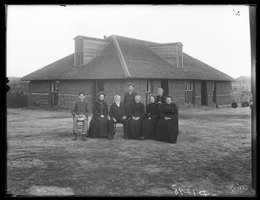

If you had a hill on your claim, you might construct a dugout. By digging into the hill, you immediately had a back wall and two of your side walls. Dugouts were cramped, often no more than ten feet square, but they provided quick shelter, allowing the settlers to turn their attention to the other survival needs of providing food and water.


The early settlers who came to Nebraska selected home sites where they found familiar materials to build their dwellings. Along timber covered rivers like the Missouri and Republican, log and lumber houses were common. In the few places in Nebraska where you find stone outcroppings, stone was dug out and used. Where there was clay, people made houses out of adobe, or built walls by tightly pounding dirt into forms to make a solid wall.
But in many places in Nebraska those building materials were simply not to be found, and so settlers turned to sod. As far as we know, the first building made out of sod, and not adobe, was at Fort Kearny in the late 1840s.Over the years, by trial and error, newcomers to Nebraska learned how to work with sod. For those who came with little or no money, they were inexpensive to build. You needed money only for windows, doors, and whatever lumber was needed for the roof. With walls made of tightly packed sod, two to three feet thick, these buildings did an excellent job of dealing with the extremes of Nebraska’s climate. In the winter these walls held in heat, and in the summer, they stayed comfortably cool.
What was it like to live in a sod house? Was it better to live in a wood-framed house?
Soon, the cabin no longer met the needs of the settlers, and within a year or two, they would build their first permanent house. Many of the same methods that they used for their cabins were used for the first house. Like cabins, the first house could be made of a variety of materials, including stone, logs, clay, and lumber.
